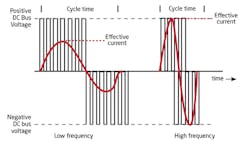Who knew that simply spinning and moving things could involve so many choices? Motors and their associated drives come in a bewildering variety of types and technologies from simple ac and dc motors, which are connected directly to power, to the latest sophisticated linear servo drives with absolute encoders and precision positioning to within microns. The evolution of motors and drives has been nothing if not impressive and confusing.
Alternating-current (ac) motors immediately gained acceptance over dc in most industries due to their efficiency, torque and power, not to mention they are cleaner and less maintenance-intensive than direct-current (dc) motors due to the lack of carbon brushes, which produce carbon dust, and commutators, which need occasional “stoning” or grinding to flatten and level the contact surfaces for the brushes.
Also read: Smarter drives means more useful motors
However, one big functional difference between the two is that a dc motor’s speed can be controlled by simply lowering or raising the supply voltage, whereas an ac motor’s cannot be. By design, the typical three-phase induction motor will run at a set speed that is dictated by the incoming ac frequency and the number of magnetic poles built into the motor. The relationship follows this equation:
rpm = 120 x frequency/number of poles.
So, for example, a four-pole motor connected to a 60 Hz incoming power would spin at a fixed 1,800 rpm.
Therefore, the easiest way to change the speed of an ac motor is to change the frequency of the incoming power. However, you cannot call up the power utility and ask that it supplies a different frequency power to the grid. Well, you can, but the answer will be a resounding no. But changing the supply frequency to the motor is exactly what a variable-frequency drive (VFD) does. Developed in the 1960s after the development of transistors required in the drive, VFDs were introduced as an efficient way to control the speed of individual ac motors. Prior to the VFD, there was no robust, effective way to control the speed of an ac motor.
By rectifying the incoming ac power into dc and then using transistors to chop the dc bus voltage into pulse-width-modulation (PWM) sine waveform to emulate a new incoming ac supply to the motor, the voltage and frequency, and thus current, are now able to be fully controlled by the drive. The drive can decrease the frequency to run the motor at a lower speed even down to a stop or increase the frequency to even higher than the standard 60-Hz power would dictate to run the motor faster (Figure 1).
The windings of the motor, which are basically inductors, have the effect of smoothing out the PWM’s “chopped” nature, and the resulting current resembles a smooth sine wave.
However, simply lowering the speed, or frequency, of an ac motor results in lower inductive reactance of the windings, the equivalent to resistance in a dc circuit, which allows more current to flow through the windings if the voltage is not lowered, so this needs to be accounted for.
Also, since motor cooling fans typically are attached directly to the rotor, a slower-spinning motor has less airflow to cool the internals, including the windings. Both factors can cause the windings to overheat. The VFD compensates for this by also lowering the voltage when the input frequency is below 60 Hz, maintaining an ideal Volts-to-frequency ratio constant. This makes the motor run more efficiently—less heat loss. Additionally, VFD-specific ac motors have special windings that are optimized to run at a wide range of input frequencies to prevent any issues with heat at lower speeds, so long as a VFD is used to control them.
The drive has complete control over all three phases of ac power to the motor, so stopping the motor, starting and ramping up speed and even reversing the direction of the motor are all natural functions of the VFD. Obviously, these characteristics of operation lend themselves well to any application where variable speed down to and including stopping and reversing direction would be important.
Additional features that have been added to many VFD offerings in the past decade or so include more onboard functionality in the controller, such as proportional-integral-derivative (PID) control loops for active control of speed or torque, which is very important for variable load situations such as grinding or driving pumps.
External communications with high-speed Internet or other fieldbuses also allows the drive to become part of a networked system, coordinating or even synchronizing its motion with other drives or devices in the application.
VFDs have come a long way, but they have also introduced a way to teach an old dog new tricks, in this case the old dog is the ac motor, and the new tricks are all of the functionality that VFDs provide.
About the Author

Joey Stubbs
contributing editor
Joey Stubbs is a former Navy nuclear technician, holds a BSEE from the University of South Carolina, was a development engineer in the fiber optics industry and is the former head of the EtherCAT Technology group in North America.

Leaders relevant to this article:

